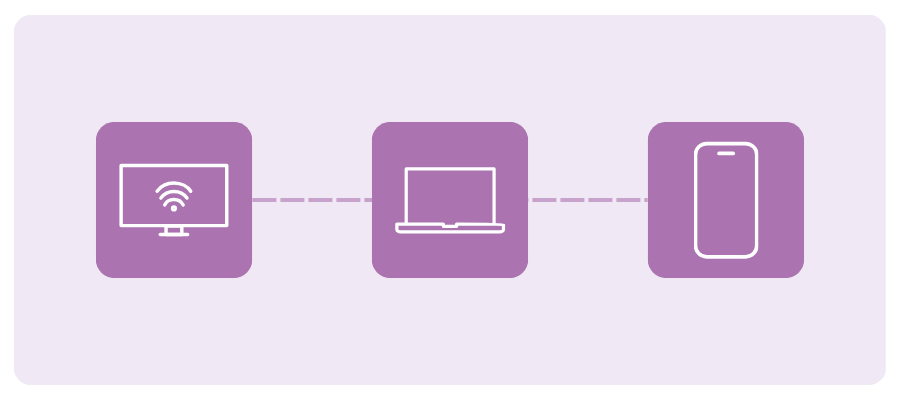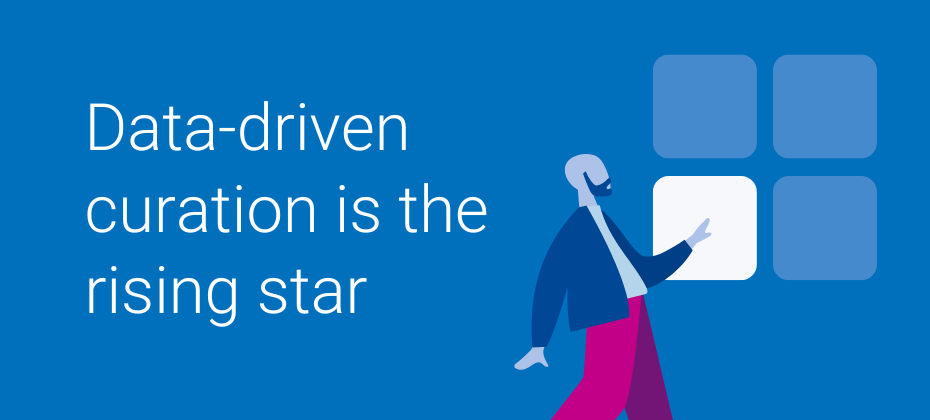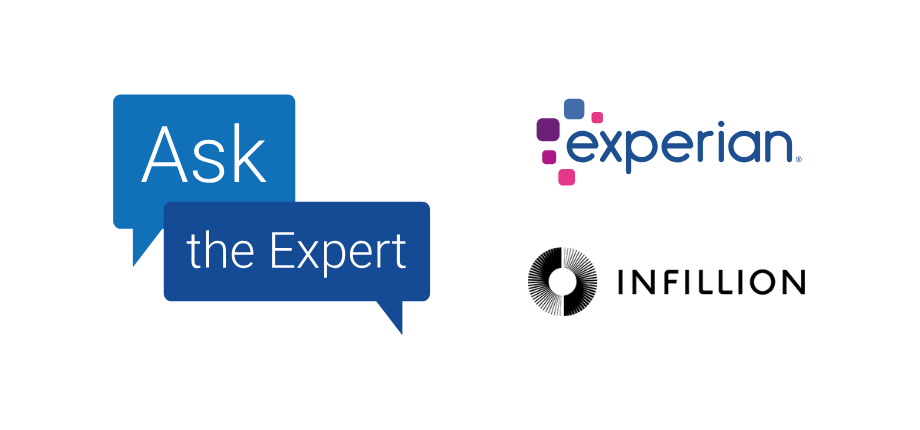At A Glance
Infillion and Experian collaborate to help advertisers connect with audiences across devices and channels, as cookies and mobile identifiers disappear. By integrating Experian's Digital Graph and Offline Identity Resolution, Infillion strengthens identity connections, improves campaign reach, and enhances audience engagement across CTV, mobile, and web.In our Ask the Expert Series, we interview leaders from our partner organizations who are helping lead their brands to new heights in AdTech. Today’s interview is with Ben Smith, VP of Product, Data Products at Infillion.
Adapting to signal loss
What does the Experian–Infillion integration mean for advertisers looking to reach audiences as signals fade?

As cookies and mobile identifiers disappear, brands need a new way to find and reach their audiences. The Experian integration strengthens Infillion’s XGraph, a cookieless, interoperable identity graph that supports all major ID frameworks, unifying people and households across devices with privacy compliance, by providing a stronger identity foundation with household- and person-level data. This allows us to connect the dots deterministically and compliantly across devices and channels, including connected TV (CTV). The result is better match rates on your first-party data, more scalable reach in cookieless environments, and more effective frequency management across every screen.
Connecting audiences across channels
How does Experian’s Digital Graph strengthen Infillion’s ability to deliver addressable media across channels like CTV and mobile?

Experian strengthens the household spine of XGraph, which means we can accurately connect CTV impressions to the people and devices in that home – then extend those connections to mobile and web. This lets us plan, activate, and measure campaigns at the right level: household for CTV, and person or device for mobile and web. The outcome is smarter reach, less waste from over-frequency, and campaigns that truly work together across channels.
The value of earned attention
Infillion has long championed “guaranteed attention” in advertising. How does that philosophy translate into measurable outcomes for brands?

Our engagement formats, such as TrueX, are based on a simple principle: attention should be earned, not forced. Viewers choose to engage with the ad and complete an action, which means every impression represents real, voluntary attention rather than passive exposure. Because of that, we consistently see stronger completion rates, deeper engagement, and clearer downstream results – like lower acquisition costs, improved on-site behavior, and measurable brand lift.
To take that a step further, we measure attention through UpLift, our real-time brand lift tool. UpLift helps quantify how exposure to a campaign influences awareness, consideration, or purchase intent, providing a more complete picture of how earned attention translates into business impact.
Creative innovation and location insights
Beyond identity resolution, what are some of Infillion’s capabilities, like advanced creative formats or location-based insights, that set you apart in the market?

One key area is location intelligence, which combines privacy-safe geospatial insights with location-based targeting through our proprietary geofencing technology. This allows us to build custom, data-driven campaigns that connect media exposure to real-world outcomes – like store visits and dwell time – measured through Arrival, our in-house footfall attribution product.
We also build custom audiences using a mix of zero-party survey data, first-party location-based segments, and bespoke audience builds aligned to each advertiser’s specific strategy.
Then there’s creative innovation, which is a major differentiator for us. Our high-impact formats go beyond static display, such as interactive video units that let viewers explore products through hotspots or carousels, rich-media ads that feature polls, quizzes, dynamic distance, or gamified elements, and immersive experiences that encourage active participation rather than passive viewing. These creative formats not only capture attention but also generate deeper engagement and stronger performance for a variety of KPIs.
Future ready media strategies
How does Infillion’s ID-agnostic approach help brands future-proof their media strategies amid ongoing privacy and tech changes?

We don’t put all our eggs in one basket. XGraph securely unifies multiple durable identifiers alongside our proprietary TrueX supply to strengthen CTV household reach. This agnostic design allows us to adapt as platforms, regulations, and browsers evolve – so you can preserve reach and measurement capabilities without getting locked into a single ID or losing coverage when the next signal deprecates.
Raising the bar for media accountability
Looking ahead, how is Infillion evolving its platform to meet the next wave of challenges in audience engagement and media accountability?
From an engagement standpoint, we’re expanding our ability to support the full customer journey, offering ad experiences that move seamlessly from awareness to consideration to conversion. That includes smarter creative that adapts to context, intelligent targeting and retargeting informed by real data, and formats designed to drive measurable outcomes rather than just impressions.
When it comes to accountability, we’re ensuring that measurement is both flexible and credible. In addition to our proprietary tools, we partner with leading third-party measurement providers to validate results and give advertisers confidence that their investment is truly performing. Within our DSP, we emphasize full transparency and log-level data access, ensuring advertisers can see exactly what’s happening on every impression.
All of this builds toward the next era of agentic media buying – one enabled by our MCP suite and modular, component-based tools. This evolution brings greater accountability and next-generation audience engagement to an increasingly automated, intelligent media landscape. Our goal is to help brands connect more meaningfully with audiences while holding every impression – and every outcome – to a higher standard of transparency and effectiveness.
Driving impact across the funnel
What is a success story or use cases that demonstrate the impact of the Experian–Infillion integration?
We recently partnered with a national veterans’ organization to raise awareness of its programs for injured or ill veterans and their families. Using the Experian integration, we combined persistent household- and person-level identifiers with cross-device activation to reach veteran and donor audiences more precisely across CTV, display, and rich media. The campaign achieved standout results – industry-leading engagement rates, a 99% video completion rate, and measurable lifts in both brand awareness (3.6 % increase) and donation consideration (13.7% lift). It’s a clear example of how stronger identity and smarter activation can drive meaningful outcomes across the full funnel.

Contact us
Identity resolution FAQs
Identity resolution ensures accurate connections between devices, households, and individuals. Experian’s Offline Identity Resolution and Digital Graph strengthen these connections for improved targeting and consistent measurement across CTV, mobile, and web.
Solutions like Experian’s Digital Graph enable brands to connect first-party data to household and person-level identifiers, ensuring scalable reach and compliant audience targeting legacy signals fade.
Focusing on earned attention (where audiences actively choose to engage) leads to stronger completion rates, improves on-site behavior, and drives measurable increases in brand awareness and consideration.
By linking CTV impressions to households and extending those connections to mobile and web, Experian’s identity solutions ensure campaigns work together seamlessly, reducing over-frequency and improving overall reach.
About our expert

Ben Smith
VP Product, Data Products, Infillion
Ben Smith leads Infillion’s Data Products organization, delivering identity, audience, and measurement solutions across the platform. Previously, he was CEO and co-founder of Fysical, a location intelligence startup acquired by Infillion in 2019.
About Infillion

Infillion is the first fully composable advertising platform, built to solve the challenges of complexity, fragmentation, and opacity in the digital media ecosystem. With MediaMath at its core, Infillion’s modular approach enables advertisers to seamlessly integrate or independently deploy key components—including demand, data, creative, and supply. This flexibility allows brands, agencies, commerce and retail media networks, and resellers to create tailored, high-performance solutions without the constraints of traditional, all-or-nothing legacy systems.
Latest posts

In the past, first-party onboarding focused on activating a brand’s own customer data, while third-party onboarding allowed advertisers to tap into external audiences. But the rise of commerce media networks (CMNs) — which now influence over 14% of all digital ad spend — has blurred those once-clear lines. CMNs, retail media ecosystems, and brand partnerships are reshaping how data is shared, accessed, and activated. Today, the question isn’t just who owns the data but why it’s being used. Whether to strengthen customer relationships or create new revenue opportunities, intent now shapes how data must be governed, shared, and measured. For brands with strong first-party data, this shift creates opportunities to deliver more personalized, privacy-safe campaigns to their own audiences and to extend that data’s value by enabling partners to reach new segments. In this connected ecosystem, data onboarding enables brands to activate, scale, and monetize their data responsibly, turning first-party insights into privacy-led growth opportunities. Trusted onboarding partners like Experian can help marketers activate first-party audiences with accuracy while scaling and connecting those audiences across the ecosystem for compliant, revenue-generating collaboration. What is data onboarding? Data onboarding moves offline consumer data — like CRM records, loyalty details, or transaction histories — into digital environments for activation and measurement. It connects real-world insight with digital engagement across display, social, search, connected TV (CTV), and commerce media. Data onboarding is now a strategic pillar for marketers managing signal loss, disconnected data, and rising privacy expectations. The approach you take and who owns the data determine what kind of onboarding it is: First-party onboarding: A brand activates its own customer data across digital platforms. Third-party onboarding: A brand enables others to use its data, often monetizing it — common in CMNs or commerce media ecosystems. Experian helps marketers succeed in both models. With AI-driven identity resolution, persistent identifiers, and privacy-first infrastructure, we make onboarding accurate, compliant, and scalable, regardless of who owns the data. Why do marketers need data onboarding? Even the most data-rich brands often have a limited view and reach when it comes to their audiences. They’re confined to the data they collect directly and to the owned channels they use to engage those people. Customer files may reveal who’s already in the ecosystem, but not always where those people spend time, how they behave across channels, or why they make certain decisions. Onboarding bridges that gap. It transforms offline data into digital activation power, allowing marketers to connect insight with action. Experian makes this possible at scale with trusted identity resolution, data ranked #1 in accuracy by Truthset, audience modeling expertise, and seamless data integration across platforms, helping marketers activate confidently and compliantly. With Experian’s onboarding solutions, marketers can achieve: Unified customer identity across devices, channels, and touchpoints. Cross-channel personalization with consistent, relevant messaging wherever customers engage. Scaled, privacy-compliant reach beyond owned channels without sacrificing control or consent. Better insights and audience creation by blending first-party and Experian Marketing Data for a deeper understanding. Cross-channel activation with deep integrations into the advertising ecosystem. Core steps in the onboarding process While onboarding can vary across use cases, the core process remains consistent. Experian’s AI-enhanced identity infrastructure streamlines every stage of data migration and activation, making each step safer and faster: Data ingestion: Transfer the data into the onboarding environment using privacy-safe encryption and consented parameters to protect sensitive information responsibly from the start. Transformation: Cleanse, standardize, and format records to align with digital identifiers. This eliminates inconsistencies and makes every record easier to recognize and activate later. Identity resolution: Link offline identifiers (names, emails, addresses) to hashed digital equivalents like mobile advertising IDs (MAIDs), CTV IDs, and universal IDs via Experian’s Offline and Digital Graphs. Identity resolution connects customers to their digital presence without exposing personal information. Identity matching: Match hashed emails, MAIDs, and device-graph identifiers to activation partners for each audience across demand-side platforms (DSPs), social, and CTV platforms. This expands your audience reach while maintaining accuracy and privacy. Activation: Deliver privacy-safe audiences to DSPs, social, search, or CMN shelves from third-party data providers (not the CMN’s own data) — or directly to an advertiser’s seat for immediate activation. You’ll turn insights into action and be able to reach the right people with relevant, compliant messaging. Behind this flow is Experian’s identity graph, which links 250 million U.S. individuals, 900 million hashed emails, and 4.2 billion digital identifiers refreshed weekly. It’s the foundation that keeps onboarding accurate as the signal landscape shifts. First-party vs. third-party onboarding Every digital marketing data point has a story, but whose story it tells depends on who’s using it. That distinction defines the difference between first-party and third-party onboarding. Both are essential to modern marketing, but they carry different expectations for control, consent, and accountability. First-party onboarding: Activate your own data safely and strategically First-party onboarding starts with the data a brand earns directly from its own customers through trusted relationships. This data belongs to the brand, as customers have given consent, and the brand has the responsibility (and opportunity) to use it well. That data might include: CRM records Loyalty-program data Purchase or transaction histories Website or app interactions Email subscribers or reward members How first-party onboarding works in practice The onboarding process connects this offline data to digital identity so marketers can reach their existing customers across channels. For example, a credit card company might take its CRM file of cardholders, hash the email addresses, and upload that file to a DSP via Experian’s Audience Engine. Experian’s identity graph resolves those emails to privacy-safe digital identifiers like MAIDs, CTV IDs, or universal IDs. The result is a ready-to-activate audience that can be reached on CTV, social, and display without exposing raw personally identifiable information (PII). Why control matters in first-party onboarding The advantage of first-party onboarding is control; the brand decides what to share and how to use it. It’s a powerful way to: Personalize messages for known customers Re-engage lapsed buyers or loyalty members Suppress existing customers from prospecting campaigns Measure performance with closed-loop attribution Doing first-party onboarding responsibly That control comes with responsibility. Even consented customer data that has been consented to can pose risks if handled carelessly or shared with unverified partners. Experian’s First-Party Onboarding sits on a privacy-first identity foundation, governed by decades of compliance leadership under laws like the Gramm-Leach-Bliley Act (GLBA) and Fair Credit Reporting Act (FCRA). We connect data and identity responsibly, so marketers can activate with confidence while protecting consumers. Why first-party onboarding matters First-party onboarding is the cornerstone of responsible marketing. It allows brands to deepen relationships they already have, using data that customers have freely shared. And with Experian’s secure First-Party Onboarding, that data stays encrypted, compliant, and under the brand’s control from start to finish. Third-party onboarding: Share and monetize data responsibly Third-party onboarding begins when a brand allows someone else to use its data. It’s how data providers, publishers, and especially CMNs monetize their audiences — turning first-party customer insights into addressable, privacy-safe segments that advertisers can buy and activate across digital channels. How third-party onboarding works in practice Think of it as data collaboration at scale. Let’s say a retailer collects first-party shopper data like product purchases, loyalty card usage, and store visits. Then, they partner with Experian to make that audience available to outside advertisers, such as a consumer packaged goods (CPG) brand. Through Experian Third-Party Onboarding, those audiences are resolved, privacy-protected, and distributed to integrated destinations such as The Trade Desk, Magnite, or NBCUniversal for activation. To the retailer, it’s their first-party data. To the CPG, it’s third-party data they can use for targeted campaigns. To Experian, it’s an opportunity to ensure the entire exchange is accurate and compliant. Why scale matters in third-party onboarding The benefit of third-party onboarding is scale. It enables data owners to monetize their insights, while giving advertisers access to richer audiences they couldn’t build on their own. It’s the engine behind CMNs, commerce media, and the growing data-sharing economy. With a partner like Experian, that scale becomes even more powerful. Our advanced modeling and identity solutions help brands expand their audiences responsibly using lookalike and predictive modeling to identify high-value segments, increase reach, and maximize performance across every activation channel. The responsibilities of data sharing in third-party onboarding As data ecosystems grow, so does the opportunity to collaborate responsibly. Once data leaves its original owner’s ecosystem: Consent obligations become more complex. Control over downstream usage can blur. Regulatory oversight increases, especially around transparency and consumer rights. With the right governance in place, these responsibilities can help strengthen partnerships, protect consumers, and create a foundation for sustainable growth. Experian’s ethical enablement role in third-party onboarding Experian’s enablement role is both technical and ethical. Our deep expertise enables us to partner with brands and support their monetization efforts, helping them derive new value from their data while maintaining the highest standards of privacy and compliance. Meanwhile, our infrastructure ensures third-party data onboarding happens securely and transparently: Identity resolution expands reach without overexposing identifiers. Data verification and governance ensure partners meet strict privacy standards. Revenue-share structures maintain fairness without hidden costs. Cross-channel integrations enable you to onboard your data once and activate it everywhere (programmatic, CTV, or social) through Experian’s 30+ direct and 200+ indirect destination partnerships. Why third-party onboarding matters Third-party onboarding is the foundation of modern data collaboration. When done through Experian, it becomes a trusted extension of your brand’s identity governed by the same privacy, consent, and accuracy standards that strengthen your first-party ecosystem. We help brands uncover new opportunities for growth, partnership, and responsible innovation. When first-party onboarding turns into third-party onboarding When data ownership shifts, privacy expectations change, and the rules of onboarding start to look a little different. This stage can feel complex, but with the right approach, the crossover becomes clear. It’s a natural evolution that helps brands connect data more effectively and collaborate confidently. Here’s what that can look like in practice. A retailer uses its own first-party data to engage loyal shoppers through its website, app, or email program. The data is secure, consented, and fully under the retailer’s control. Then comes collaboration. The retailer decides to partner with a brand, like a CPG company, to reach those same shoppers across connected TV or the open web. In that moment, the retailer’s first-party data becomes the CPG’s third-party data. Ownership doesn’t really change, but accountability does, along with new privacy and compliance considerations. This “crossover moment,” when first-party onboarding turns into third-party activation, is a small shift with big potential that can lead to new reach, deepen collaboration, and strengthen customer connections across the marketing ecosystem when managed responsibly. Why clarity matters in the crossover between first- and third-party onboarding When data starts flowing beyond owned channels, questions naturally come up. Marketers want to know things like: Who “owns” the audience once it’s shared with a partner or DSP? Whose privacy notice applies — the retailer’s, the brand’s, or both? How do we keep match accuracy without overexposing PII? Who’s responsible for opt-outs and suppression compliance downstream? These are the right questions to be asking, and they’re signs of a mature, data-driven strategy. Asking them is what helps brands strengthen governance, build trust, and get more value from collaboration. With the right framework in place, what could feel complicated becomes clear, opening the door to more confident growth across CMNs and other shared-data environments. How Experian brings clarity and control to the first- and third-party onboarding crossover As a neutral, privacy-first partner, we provide the infrastructure that keeps data secure, compliant, and meaningful wherever it flows. Our onboarding solutions help both sides of the partnership — retailers and advertisers — maintain trust through: Clear ownership and consent management: Experian enforces data-handling rules that preserve each party’s control. Every record is matched and activated in accordance with strict consent parameters and Global Data Principles that exceed industry standards. Accurate, privacy-safe identity resolution: Our Offline and Digital Graphs connect people to their devices, households, and behaviors using hashed identifiers, ensuring match precision while protecting individuals. AI-powered contextual intelligence: Experian’s AI models analyze real-world behavior and contextual signals to enhance match quality and extend reach without reliance on cookies. For CMNs, that means better off-site activation, targeting the right shoppers in the right environments while maintaining compliance. Trusted integrations and transparent reporting: With direct integrations into 30+ programmatic and TV destinations, Experian delivers consistent match rates and unified measurement through solutions like Activity Feed and Experian Outcomes. This is how Experian transforms complex data challenges into seamless, scalable collaborations that give marketers the confidence to expand responsibly into commerce media and commerce ecosystems. The new standard of responsible AI and commerce media Commerce media represents the future of audience activation, but only if the transition is managed responsibly. As the lines blur between data ownership and activation rights, Experian’s AI-driven, privacy-first identity framework acts as the connective tissue between retailers, brands, and platforms. We help CMNs: Enrich shopper data with Experian Marketing Attributes for deeper insights. Extend addressability off-site using privacy-safe identity resolution. Optimize activation through real-time, contextually aware audience expansion. Measure results transparently through privacy-compliant feedback loops. In short, we ensure that when your first-party onboarding becomes third-party activation, trust and performance stay intact. Why choose Experian's onboarding solutions? Many view onboarding as a data transfer, but we treat it as a trust process where accuracy, privacy, and performance align. Here’s why marketers choose us: 1. Unmatched data and identity foundation When brands struggle with incomplete or siloed customer data, Experian’s unified foundation connects fragmented records into a single, accurate identity. Our Offline and Digital Graphs link households, individuals, and devices with persistent accuracy. Updated weekly and built on decades of historical data, our graphs maintain 97% household coverage across the U.S., even through signal loss. 2. Privacy-first and compliance-led Given tightening regulations and growing consumer expectations, privacy compliance is essential. With decades as a regulated data steward, we apply the same rigorous controls from our financial operations to marketing data. Every data partner is verified for transparency and compliance with consent requirements, and all consumer data is governed by Experian’s Global Data Principles, which exceed industry standards. We help brands meet their privacy and consent obligations confidently while maintaining the data integrity that drives results. 3. Real-time, contextual activation Experian’s industry-leading Offline and Digital Graphs are widely adopted across the advertising ecosystem, powering identity resolution and audience activation for the world’s top marketers. Our integrations span 30+ direct and 200+ indirect activation platforms, including leading DSPs, CTV networks, and commerce environments. With real-time, AI-driven contextual intelligence, Experian enables privacy-safe targeting even in signal-limited environments through solutions like Contextually-Indexed Audiences that deliver reach without reliance on cookies or personal identifiers. 4. Platform flexibility Modern marketing requires interoperability. Experian’s onboarding framework is technically integrated across multiple platforms, offering brands and data providers the freedom to activate where they choose. Whether through self-service onboarding in Audience Engine for first-party data or managed onboarding for third-party monetization, Experian scales with your organization, providing transparent pricing, seamless delivery, and dedicated support teams to ensure every connection performs. 5. Human-centered innovation Marketing should strengthen relationships and build trust. Our AI-driven identity systems are designed to protect privacy, respect individuals, and create real human value — helping brands connect with people meaningfully. They aren’t built to collect more data but to make better use of the data you already have by connecting insights responsibly and ethically. Every innovation at Experian is guided by the principle of balancing personalization with compliance. Top use cases for Experian’s onboarding solutions Our onboarding solutions are transforming how brands operate across industries every day. Whether you’re deepening loyalty, expanding reach, or proving performance, Experian helps connect data responsibly to drive measurable results. Here’s where we make the biggest impact: Automotive: Connect purchase intent data with digital identifiers for more efficient targeting. Commerce media: Use both first- and third-party onboarding — first-party for on-site activation and owned marketing, third-party for off-site activation and monetization — all while maintaining compliance and accurate attribution. CPG: Activate shopper data through retailer partnerships to drive off-site reach and stronger brand collaboration. Data providers: Monetize audience segments across Experian’s programmatic and TV integrations. Financial services: Deliver compliant, personalized cross-channel offers with unified identity. Healthcare: Use National Provider Identifier (NPI) onboarding to reach healthcare professionals compliantly. Retail: Power loyalty personalization, partner monetization, and CMN audience activation. Across each use case, Experian’s privacy-first identity foundation turns data onboarding into a trusted driver of growth and stronger customer relationships. Navigate the new data economy with Experian Data onboarding has come a long way, mirroring the changes in marketing itself. We’ve moved from relying on third-party cookies to empowering first-party data, and now to building collaborative ecosystems like CMNs. At Experian, we’re right in the middle of that evolution. With decades of data expertise, privacy leadership, and AI-driven activation, we help marketers connect more responsibly, measure what matters, and grow with confidence. Want to see what that looks like for your brand? Let’s build safer connections together. Start connecting responsibly Data onboarding FAQs What is Experian First-Party Onboarding and Third-Party Onboarding? Experian First-Party Onboarding helps brands take the customer data they already own, like CRM lists or loyalty files, and use it safely across digital channels for targeting, personalization, and measurement. Experian Third-Party Onboarding helps retailers, publishers, and data providers share or monetize their audiences responsibly with partners through secure, privacy-first activation.Both are powered by Experian’s trusted identity foundation that keeps every connection accurate, compliant, and privacy-safe. What’s the difference between first-party and third-party data onboarding? The difference between first- and third-party onboarding is who’s using the data. First-party means a brand is activating its own customer information, while third-party means that data is being shared or used by another advertiser or partner. When does first-party onboarding become third-party onboarding? First-party onboarding becomes third-party onboarding most often in CMNs or commerce media. When a retailer monetizes its first-party shopper data for use by CPGs or advertisers, the use case shifts to third-party onboarding. Why do marketers need both first- and third-party onboarding? First-party onboarding helps brands reach and understand their existing customers, while third-party onboarding helps expand reach, enable partnerships, and monetize data responsibly. Latest posts

If you buy media today, you’re already feeling the shift: the best results don’t always come from broad, open auctions or static “safe site” lists; they’re coming from deals that combine the right data with the right inventory and let algorithms optimize in real time. That’s curation. And when it’s done right, it reduces data and media waste for buyers and raises eCPMs (effective cost per thousand impressions) and win rates for publishers. As part of our Cannes Content Studio series, leaders from Butler/Till, Index Exchange, OpenX, PubMatic, and Yieldmo discuss how curation cuts waste and lifts results. What is real curation? Real curation isn’t “packaging inventory.” It’s a strategic framework built on three pillars: 1. Unique data Privacy-compliant and accurate. 2. Strong supply connections Access to quality inventory from publishers at scale. 3. Optimization tools To measure, refine, and improve performance throughout the campaign lifecycle. Why it matters: Manual approaches hit a ceiling. They can’t react quickly to shifting content, identity signals, or auction dynamics. That’s where technology partners come in, keeping the optimization loop running continuously. Intelligence at every touchpoint Curation isn’t about shifting control between platforms. It’s about better brand decisions, connecting opportunity-rich supply to the brand’s preferred buying platform and enriching each buy with audience data. In practice, supply-side platforms (SSPs) are ingesting richer signals to route inventory more effectively and support frequency caps and deal prioritization, in collaboration with demand-side platforms (DSPs). "I think we’re seeing a shift toward bringing more DSP capabilities into the SSP, like supply-side targeting and data driven curation. Advancements in areas like CTV are enabling targeting based on content signals, and SSPs are pulling in more data to inform which supply is sent to the DSP, helping with things like frequency caps."Matt Sattel Why page-level targeting beats static lists Static domain lists were a useful first step for quality control. The intent was sound, but the approach was too cumbersome for today’s signal-rich buying. Today, AI and contextual engines read the page, not just the site, and adapt in real time. Page-level logic delivers three key benefits: Accuracy by targeting high-intent, page-level content. Relevance by matching the creative to both the content and the audience context. Speed by enabling campaigns to move away from underperforming pages in real time, without waiting for a manual trafficking change. "AI-driven contextual engines evaluate the page, not just the domain, to curate inventory in real time. That moves curation from static allowlists to adaptive logic for greater accuracy, relevance, and speed."Sophia Su Partnerships broaden who influences the buy Curation works when publishers, agencies, data partners, and platforms share signals and KPIs. Horizontal curation (across multiple SSPs) assembles broader, higher-quality reach and resilience, ideal for scale and diversity of supply. Vertical curation (an SSP’s in-house product) provides deep controls within a single exchange, useful for specific inventory strategies. Creative and data now shape supply and demand: better creative decisioning, tested against richer signals, improves outcomes. DSPs remain central for activation and pacing. But the sell-side’s growing intelligence means more accurate inventory routing and signal application before a bid ever fires. "Curation will continue to evolve through deeper data partnerships and expanded use across publishers and agencies, with more sophisticated types of optimization. DSPs will remain critical to activation, even as sell-side decisioning plays a larger role in identifying and shaping the supply to select."Mike McNeeley Curation delivers access and measurable performance Here’s what curated deals are delivering. For buyers ResultType of result36-81%savings on data segments10-70%lower cost per click (CPCs)1.5-3xhigher click-through rates (CTRs)10-30%higher video completion rates For publishers ResultType of result20%bid density118%win rate10%revenue on discovered inventory25%eCRM on incremental impressions Why it works: When data, supply, and optimization are integrated, you reduce waste, surface better impressions, and let algorithms compound your advantage. That’s why curated private marketplaces (PMPs) have grown at ~19% compound annual growth rate (CAGR) since 2019. "Publishers using supply-side curation see ~15% more diverse buyers and 20–25% better performance than buy-side-only targeting. Smarter packaging and signal application tighten auctions and strengthen outcomes."Howard Luks Holistic curation streamlines planning and outcomes Curation adds the data layer earlier in the buying process, starting at the supply-side. This creates more opportunities to reach the right audience and improves scale and performance. By replacing multiple line items with a single curated deal, campaign setup becomes faster and less error-prone. Curated deals also simplify measurement by including the necessary context for accurate attribution, while dynamic adjustments ensure campaigns remain optimized without requiring manual updates. "Publishers using supply-side curation see ~15% more diverse buyers and 20–25% better performance than buy-side-only targeting. Smarter packaging and signal application tighten auctions and strengthen outcomes."Gina Whelehan It’s much more streamlined, bringing more pieces together so we’re thoughtful and holistic. Adding the audience and data element creates more scale and strategy in how we curate supply and data, and ultimately better results for clients. The bottom line Curation has matured from buzzword to performance system. DSPs still anchor activation and pacing, but better sell-side pipes now pre-route inventory and apply signals before any bid starts, making the whole system faster and more accurate. When you combine unique signals, tight supply connections, and always-on optimization, you gain addressability, reduce waste, and achieve better business outcomes for both buyers and sellers. Curation isn’t just a trend; it’s where programmatic advertising is headed. Start testing curated PMPs today to see the difference for yourself. Explore curated PMPs with Audigent Curation FAQs What is curation in performance marketing? Curation in performance marketing is the process of combining data, inventory, and optimization to deliver better results. Audigent supports curated strategies through privacy-safe data and advanced integrations. How does curation benefit marketers? Curation reduces wasted spend by targeting high-quality impressions and optimizing campaigns in real time. Audigent’s solutions help marketers achieve higher click-through rates, lower costs, and better engagement across channels. What are curated PMPs, and why are they important? Curated PMPs are deals that use curated data and inventory to deliver measurable results. They help buyers save on data costs, improve ad performance, and achieve better video completion rates, while publishers see higher win rates and revenue. How does Audigent support curated strategies? Audigent provides unique data assets, privacy-safe integrations, and optimization tools that help marketers and publishers create curated deals. Our solutions ensure campaigns are more efficient, targeted, and effective from start to finish. What’s the difference between horizontal and vertical curation? Horizontal curation combines inventory across multiple platforms for broader reach and diversity, while vertical curation focuses on deep control within a single platform. Both approaches can be tailored to specific campaign goals with Audigent's expertise. Latest posts

In our Ask the Expert Series, we interview leaders from our partner organizations who are helping lead their brands to new heights in AdTech. Today’s interview is with Ben Smith, VP of Product, Data Products at Infillion. Adapting to signal loss What does the Experian–Infillion integration mean for advertisers looking to reach audiences as signals fade? As cookies and mobile identifiers disappear, brands need a new way to find and reach their audiences. The Experian integration strengthens Infillion’s XGraph, a cookieless, interoperable identity graph that supports all major ID frameworks, unifying people and households across devices with privacy compliance, by providing a stronger identity foundation with household- and person-level data. This allows us to connect the dots deterministically and compliantly across devices and channels, including connected TV (CTV). The result is better match rates on your first-party data, more scalable reach in cookieless environments, and more effective frequency management across every screen. Connecting audiences across channels How does Experian’s Digital Graph strengthen Infillion’s ability to deliver addressable media across channels like CTV and mobile? Experian strengthens the household spine of XGraph, which means we can accurately connect CTV impressions to the people and devices in that home – then extend those connections to mobile and web. This lets us plan, activate, and measure campaigns at the right level: household for CTV, and person or device for mobile and web. The outcome is smarter reach, less waste from over-frequency, and campaigns that truly work together across channels. The value of earned attention Infillion has long championed “guaranteed attention” in advertising. How does that philosophy translate into measurable outcomes for brands? Our engagement formats, such as TrueX, are based on a simple principle: attention should be earned, not forced. Viewers choose to engage with the ad and complete an action, which means every impression represents real, voluntary attention rather than passive exposure. Because of that, we consistently see stronger completion rates, deeper engagement, and clearer downstream results – like lower acquisition costs, improved on-site behavior, and measurable brand lift. To take that a step further, we measure attention through UpLift, our real-time brand lift tool. UpLift helps quantify how exposure to a campaign influences awareness, consideration, or purchase intent, providing a more complete picture of how earned attention translates into business impact. Creative innovation and location insights Beyond identity resolution, what are some of Infillion’s capabilities, like advanced creative formats or location-based insights, that set you apart in the market? One key area is location intelligence, which combines privacy-safe geospatial insights with location-based targeting through our proprietary geofencing technology. This allows us to build custom, data-driven campaigns that connect media exposure to real-world outcomes – like store visits and dwell time – measured through Arrival, our in-house footfall attribution product. We also build custom audiences using a mix of zero-party survey data, first-party location-based segments, and bespoke audience builds aligned to each advertiser’s specific strategy. Then there’s creative innovation, which is a major differentiator for us. Our high-impact formats go beyond static display, such as interactive video units that let viewers explore products through hotspots or carousels, rich-media ads that feature polls, quizzes, dynamic distance, or gamified elements, and immersive experiences that encourage active participation rather than passive viewing. These creative formats not only capture attention but also generate deeper engagement and stronger performance for a variety of KPIs. Future ready media strategies How does Infillion’s ID-agnostic approach help brands future-proof their media strategies amid ongoing privacy and tech changes? We don’t put all our eggs in one basket. XGraph securely unifies multiple durable identifiers alongside our proprietary TrueX supply to strengthen CTV household reach. This agnostic design allows us to adapt as platforms, regulations, and browsers evolve – so you can preserve reach and measurement capabilities without getting locked into a single ID or losing coverage when the next signal deprecates. Raising the bar for media accountability Looking ahead, how is Infillion evolving its platform to meet the next wave of challenges in audience engagement and media accountability? From an engagement standpoint, we’re expanding our ability to support the full customer journey, offering ad experiences that move seamlessly from awareness to consideration to conversion. That includes smarter creative that adapts to context, intelligent targeting and retargeting informed by real data, and formats designed to drive measurable outcomes rather than just impressions. When it comes to accountability, we’re ensuring that measurement is both flexible and credible. In addition to our proprietary tools, we partner with leading third-party measurement providers to validate results and give advertisers confidence that their investment is truly performing. Within our DSP, we emphasize full transparency and log-level data access, ensuring advertisers can see exactly what’s happening on every impression. All of this builds toward the next era of agentic media buying – one enabled by our MCP suite and modular, component-based tools. This evolution brings greater accountability and next-generation audience engagement to an increasingly automated, intelligent media landscape. Our goal is to help brands connect more meaningfully with audiences while holding every impression – and every outcome – to a higher standard of transparency and effectiveness. Driving impact across the funnel What is a success story or use cases that demonstrate the impact of the Experian–Infillion integration? We recently partnered with a national veterans’ organization to raise awareness of its programs for injured or ill veterans and their families. Using the Experian integration, we combined persistent household- and person-level identifiers with cross-device activation to reach veteran and donor audiences more precisely across CTV, display, and rich media. The campaign achieved standout results – industry-leading engagement rates, a 99% video completion rate, and measurable lifts in both brand awareness (3.6 % increase) and donation consideration (13.7% lift). It’s a clear example of how stronger identity and smarter activation can drive meaningful outcomes across the full funnel. Contact us Identity resolution FAQs Why is identity resolution critical for CTV and cross-channel campaigns? Identity resolution ensures accurate connections between devices, households, and individuals. Experian's Offline Identity Resolution and Digital Graph strengthen these connections for improved targeting and consistent measurement across CTV, mobile, and web. What strategies help address the loss of cookies and mobile IDs? Solutions like Experian's Digital Graph enable brands to connect first-party data to household and person-level identifiers, ensuring scalable reach and compliant audience targeting legacy signals fade. How can engagement translate into measurable results? Focusing on earned attention (where audiences actively choose to engage) leads to stronger completion rates, improves on-site behavior, and drives measurable increases in brand awareness and consideration. What makes cross-channel targeting more effective? By linking CTV impressions to households and extending those connections to mobile and web, Experian's identity solutions ensure campaigns work together seamlessly, reducing over-frequency and improving overall reach. About our expert Ben Smith VP Product, Data Products, Infillion Ben Smith leads Infillion’s Data Products organization, delivering identity, audience, and measurement solutions across the platform. Previously, he was CEO and co-founder of Fysical, a location intelligence startup acquired by Infillion in 2019. About Infillion Infillion is the first fully composable advertising platform, built to solve the challenges of complexity, fragmentation, and opacity in the digital media ecosystem. With MediaMath at its core, Infillion’s modular approach enables advertisers to seamlessly integrate or independently deploy key components—including demand, data, creative, and supply. This flexibility allows brands, agencies, commerce and retail media networks, and resellers to create tailored, high-performance solutions without the constraints of traditional, all-or-nothing legacy systems. Latest posts